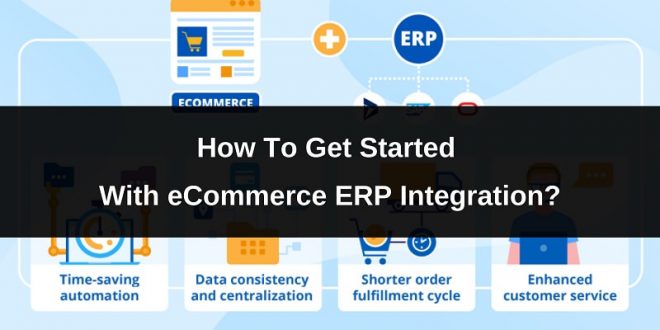Hey guys, in this article today, we are going to discuss how to get started with eCommerce ERP integration. So keep reading.
It’s not hyperbole that ERP adoption can supercharge your business. According to a survey by Panorama Consulting Group, in 2019, 88% of businesses that implemented ERP systems acknowledged an improvement in business operations. Impressive, right? However, is it feasible for all businesses? How do you get started to savor the same success?
In this article, we’ll provide eye-opening insights on eCommerce ERP integration. The information should also help you in designing an ERP integration roadmap for your business.
Let’s dive in!
What Is ERP?
Enterprise Resource Planning (ERP) is a software that is used in business management to run daily activities such as:
- Procurement,
- Accounting,
- Risk management,
- Project management,
- Compliance,
- Supply chain operations,
- Warehouse management, etc.
The ERP software automates these business functions to ensure that there is a single source of truth for all the company’s data. Examples of ERP solutions available today include SAP, SAGE, EPICOR, Netsuite, Microsoft Dynamics, etc.
In a full ERP suite, enterprise performance management software is also included. This software helps in planning, predicting, and reporting on the company’s financial results from the gathered data.
The major focus on accounting and finance is called-for as it is the heart of any business operation. According to SelectHub, 89% of the 255 companies surveyed identified accounting and finance as the most critical function of ERP. Inventory & distribution followed with 67% of the votes, CRM sales (33%), and technology (21%).
What Is ERP eCommerce Integration?
ERP eCommerce integration is the synchronization of the ERP software with data from Omni-channels and business applications of the eCommerce company. Examples of the data shared include product details, customer info, pricing, shipping, inventory, returns, taxes, etc.
Who Can Use ERP Systems?
All B2B eCommerce businesses can use ERP systems to manage their daily activities. This includes small, mid-market, and large businesses from all industry sectors–manufacturing, healthcare, accounting, finance, logistics, etc.
At the moment, manufacturers are the number one users of ERP software. This was confirmed by the Panorama Consulting group which found through studies that over 33.7% of companies using ERP solutions are in manufacturing.
Why Should eCommerce Businesses Consider ERP Integration?
Improved Use Of Data
eCommerce ERP integration allows managers to access real-time data from a single dependable source of truth. This allows critical decisions to be made timely, abating problems and improving the efficiency of processes.
According to a survey by Panorama consulting solutions, 95% of businesses with successful ERP implementations notice significant process improvements.
Inventory Visibility
Since the business management can see real-time data of the inventory, it’s easier to track out-of-stocks. This is important especially in times of crisis. Your business needs to immediately detect spikes in demand for certain products or services.
Cost Savings
According to a recent survey, 46% of businesses cited that one of the top three goals for implementing ERP integration is for cost savings. How?
When you sync your purchase information, you know how products are moving. In that case, you do not order unneeded inventory or create false projections. Also, this prevents you from relaying unreliable information to suppliers or vendors—resulting in opaque transactions.
Improved Customer Experience
An ERP integration comes with better account tracking and personalization. Customers have easy access to their shipping date, order status, order history, etc. Today, buyers favor self-services & omnichannel experiences relative to sales-rep-based assistance.
What Are The Approaches Used In eCommerce ERP Integration?
Extensive planning is the first critical step for the success of a B2B eCommerce ERP integration. The planning can start before you choose an eCommerce platform; that is if you don’t already have one.
When planning, first, understand how data will flow, map out a migration plan, find a synchronization strategy, and account for the possibility of growth in the future.
Below are the ERP integration models that can be used to initiate your eCommerce ERP integration.
Point-to-Point (P2P) Integration Model
This is commonly used when an eCommerce business has fewer applications. The integration method is lightweight and enables easy connection of one app to another.
However, though P2P integration is much easier, there are challenges when the business expands and needs more points of integration. The developer has to work hard to make every connection across the apps, systems, and devices that make up the IT infrastructure.
Middleware Integration Model
Unlike the P2P integration model where each app demands a separate connector for every connection, middleware applies a standard method where primary systems are connected to the whole network.
A centralized software is placed between these primary systems which include the ERP solution, eCommerce system, and Product Information Management. Examples of technologies with middleware capabilities are Apache, SAP HANA Cloud integration, Mulesoft, etc.
It’s important to know that there are various ways you can use to set up the middleware architecture. These include Enterprise Service Bus and HUB/ spoke models.
Enterprise Service Bus (ESB)
ESB is an architecture that is used in developing a middle integration layer. It connects applications to a communication bus, which is a messaging conduit that’s not involved in any middleware tasks.
A dedicated integration engine is available for message transformation. Routing is distributed to application adapters instead of using a central hub.
Today, most eCommerce businesses implement an EBS because of its scalability and organizational agility. Also, an EBS allows new applications to be added in a shorter time, hence getting to the market faster.
HUB/ Spoke
HUB is another type of architecture used in creating a middle integration layer. The hub and spoke concept comes from the spherical shape of a wheel.
At the center of the wheel is what’s called a hub. The hub enables spokes sprawled in all directions around the wheel to meet at the center.
In practice, a spoke connects to an app and converts the app’s data format to the one which the Hub can read. The Hub receives all the messages and transforms them into a format that can be understood by the destination system. Also, it routes the message.
If you are sure that the number of integrations will not quickly increase over time, and you have enough hardware to scale up in the future, then the Hub/spoke model is a perfect choice.
Choosing The Best Processing And Synchronization Strategy
After choosing the integration model, a business should layout two plans: the first, which is the initial data migration plan, and the second, which is the data synchronization plan.
The Initial Migration Plan
The initial migration plan must provide information such as how the customer data will be loaded to the eCommerce-ERP system. It’s imperative for data e.g. SKUs and Customer IDs to be consistent across all systems.
To ensure that there are no disparities, give time for thorough QA testing before going live. Your customers need to have a great experience from the beginning.
The Synchronization Plan
This is where you decide how data will migrate between the systems. There are two methods which are:
Real-time Integration
Here the source system is monitored continually for new transactions. This means each transaction is added in real-time. Real-time integration is perfect for time-sensitive data. However, it is expensive and can be complex, requiring top development expertise.
Batch Integration
This involves processing data matching a specific criterion into the destination—all at once. This plan is perfect if the data to be transferred is not time-sensitive.
Also, it’s the best choice if the integration between the ERP and eCommerce platform has some limitations. The disadvantage of batch integration is that it requires a lot of processing power and takes time to complete.
Choose Your eCommerce Partners With ERP In Mind
Pick an eCommerce partner that is supported by a savvy development community. The larger the development ecosystem, the easier it is for your business to adapt and flourish.
Also, consider the relationship you can build with the partner. Choose a partner that you can trust and work with within the long term.
Examples of potential partners include:
Orocommerce
An open-source B2B eCommerce platform that can integrate with any ERP solution. So far, Orocommerce has managed to integrate with SAGE, SAP, Netsuite, EPICOR, etc.
Magento
Renowned for enabling businesses to create custom integrations that leverage robust and well-documented APIs, as well as offering GraphQL support. Magento has integrated with a plethora of ERP systems such as Microsoft Dynamics, SAP, EPICOR, Oracle, Infor, etc.
Shopify
A closed-source eCommerce platform that allows you to integrate and upgrade your ERP or add connections (e.g. CRM, EDI, marketplaces) with ease. Shopify has made successful integrations with ERP systems that include EPICOR, SAP, Netsuite, Microsoft Dynamics, etc.
Wrapping Up
eCommerce ERP integration is not sophisticated and does not take time. According to a recent survey, over 49% of companies that implemented ERP systems went live in the projected time – about 13% beat their expected times, and only11% missed their mark.
Thus, do not hesitate to go down this path. When everything is done accordingly, you can enjoy improved business efficiency, achieve cost savings, and better performance metrics in no time.
 Free Web Resources , psd, mockups, & web templates Best WordPress Themes & Best Html Templates
Free Web Resources , psd, mockups, & web templates Best WordPress Themes & Best Html Templates








